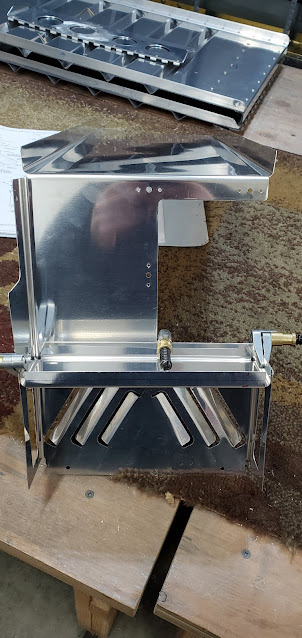Since the seat floors will go in soon and cover the conduit up, I put RTV around where the conduit passes through the bulkheads. It's purely a belt and suspenders kind of thing - it makes the conduit fit a little more snugly in the hole, which will minimize the chance of the metal cutting through the plastic and chaffing wires due to vibration. Van's said to do it on the conduit in the wings, so I figured it made sense to do it here as well.
A simple panel covers the baggage tunnel. There was really nothing to do with it other than set it in place to verify the holes line up with the nutplates. I'll prep it for installation, but it won't go in until the plane is pretty much finished.
The fore baggage side panels come mostly finished, but for whatever reason, the top flange is not cut to size. I can think of no reason that Van's would do this other than as a way to meet the 51% rule. I chopped it down and slid it into place to check the fit. This panel is also removable to allow access to the flap controls rods.

I'm starting to get a bigger pile of parts to prime, but I'm still going to do some more work before I have a full priming day. I am out of my grey EkoPrime, which is by far my favorite primer. I do still have some of the much lighter epoxy primer, but I think I'm still going to need a little bit more to finish everything. I ordered one more quart of the EkoPrime and a quart of paint as well. There's not going to be much of the interior to actually paint since I'll have interior panels and carpet in most areas, so hopefully a quart does it. I tried a test piece of the "professional" Rust-oleum spray enamel, but after two weeks it's still not cured and can be scratched with a very light rub of a fingernail. I'm going to give Stewart's paint a try (the same company that makes the primer). It's a standard waterborne acrylic urethane and should be far more durable. It's way more expensive ($110/quart), but for just a quart I didn't cry for more than few minutes. I need to get used it - when it comes to exterior paint, I'll be paying thousands of dollars for just a few gallons of paint (each gallon doubles in cost because you also have to buy an equally expensive catalyst)! It's pretty crazy how expensive paint is these days!
Next up are the seat pans and the hinges that are used to make the seating positions adjustable. Basically, the seat pan gets half of the hinge material riveted on to it and the seat back gets the other half. The standard setup is to have 3 different hinge locations on the seat pan so you can move the seat back fore and aft about 3". It'll make more sense once I have it all together and can show a picture.
The hinge material comes in long lengths that have to be cut down. I pulled the hinge pin out and started measuring and cutting. I've heard many people talk about the gotchas of this area, so I paid extra close attention to the drawings (the instructions don't provide much more than a generic "build the seats").

The drawings are very detailed, but I can see how they can bite you if you don't pay attention. You have to make sure you cut the hinges in the right places so you have eyes that are where they need to be, open spots where necessary, and on and on. Each seat floor gets 3 hinge halves. I cut 6 to the right lengths, then laid out where they go on the seat floor. Then the hinges have to be drilled for riveting. It's amazing how much time it takes to do something as simple as laying out rivet lines and drilling them. I have a lot of respect for people who built these planes prior to the existence of pre-punched parts! I don't have a picture, but I ended the day with clamping the hinges to the left seat floor and match drilling the floor to them.












































